|
History of the Colonial Veterans
Organisations
I. Early Veterans Organisations 1896-1922
Following their service in the Schutztruppe or other
overseas forces, former servicemen often entered into veteran's organisations back
home in Germany. The first of these was the Verein ehemaliger Kameraden der
afrikanischen Schutztruppen formed in Berlin in 1896. These organisations were at first small and localised
but as the numbers of former servicemen grew especially after the First World
War, so did the number of organisations.
Veterans
who had served in China belonged to the Kriegerverein ehemaliger Ostasiaten.
Veterans of the Marine Infantry joined the Verein ehemaliger See Soldaten. Veterans
who had served in the Middle East during the First World War had their own
organisation, the Bund der Asienkämpfer or BdAK. One of the main
roles of the BdAK was to try to trace soldiers (and sometimes whole units) who had
gone missing behind enemy lines after the war. Others belonged to broader
veterans groups such as the Stahlhelm or para-military groups such as the
Freikorps.
These different organisations all issued their own
badges and commemorative insignia, some examples of which are shown below from
the large collection at
Traditionsverband.
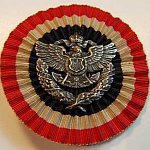
Marine Infantry
Veterans Badge
Verein ehemaliger See
Soldaten |

Cameroon Schutztruppe Veterans Badge
Verein ehemaliger
Angehöriger der kaiserlichen Schutztruppe Kamerun |
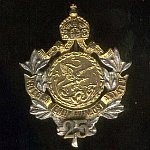
Boxer Rebellion Veterans
25th Anniversary Badge
Kriegerverein ehemaliger
Ostasiaten |
| |
|
|
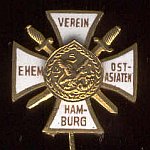
Hamburg East Asian Veterans Badge
Verein ehemaliger Ostasiaten
Hamburg |

Asienkorps
Veterans Badge
Bund der Asienkämpfer |

Colonial Red Cross Women Veterans Badge
Deutscher Frauenverein
vom Roten Kreuz für die Kolonien |
| |
|
|

Bamberg Colonial and Naval Veterans Badge
Kolonial- und
Marinetruppenverein Bamberg |
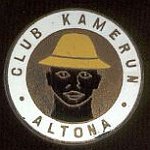
Altona Cameroon
Veterans Badge
Club Kamerun Altona |
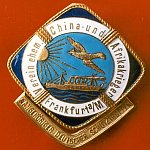
Frankfurt China and Africa
Veterans Badge
Verein ehemaliger China und
Afrikakrieger Frankfurt a/M |
II. German Colonial Veterans League DKKB
1922-45
In 1922 the former South West African
Schutztruppe officer Georg Maercker, formed the Deutsche Kolonialkriegerbund or
DKKB
intending to unite all colonial veterans organisations (although the BdAK of
Asienkorps veterans
remained separate). By 1926 they had eighty
local branches across Germany and had become one all
encompassing organisation for veterans of the all colonies and China.

Maercker with leaders of Veterans Organisations
in the 1920s
Note that some wear Schutztruppe Südwester hats and the tropical helmets of
the marine infantry and East Asian Occupation Brigade.
In 1933 the DKKB were
incorporated under the Reichskolonialbund or RKB, a large political
movement founded by former German East African Colonial Governor Dr. Heinrich
Schnee for the promotion of the return of Germany's colonies. The RKB was not just a
veterans organisation, it welcomed membership from all parts of German society.
Under pressure from the Nazi government Schnee resigned as leader of
the Reichskolonialbund in 1936 and was replaced by the former South West African Schutztruppe officer and favourite of Adolf Hitler, Franz Ritter von Epp. To promote their vision of the regained colonies the
RKB organised
'Colonial Days' in major German cities featuring speeches, DKKB veterans parades and
exhibitions of colonial artefacts.
When war broke out in 1939 the Reichskolonialbund
had a total membership of 1.3 million yet became
increasingly marginalised by the war effort and were officially disbanded in 1943 by which time
German dreams of expansion in Africa were looking highly
unlikely.
Prior to then however, from 1938 the veterans of
the DKKB had transferred from the Reichskolonialbund to being part of the
National Socialist Reichskriegerbund (also confusingly the RKB)
which was an all encompassing organisation for
veterans of
the First World War
and all previous campaigns.
III. Post-War Transformation
Like all
National Socialist organisations, the
Reichskriegerbund and its subsidiaries such as the DKKB were
disbanded after the Second World War. In 1956, the remaining colonial
veterans formed the Traditionsverband ehemaliger Schutz- und Überseetruppen
without the political and militaristic ethos of its predecessors.
This
in turn became the Traditionsverband ehemaliger Schutz- und Überseetruppen-
Freunde der früheren deutschen Schutzgebiete in 1983; as the veterans fell
their histories would be recorded by new generations. The result of which is the
Traditionsverband
website which researches historical aspects of the German
Colonies to this day.
Uniforms
of the Colonial Veterans
This is a subject which causes much
confusion amongst modern collectors, with post war veterans uniforms often
appearing very similar if not identical to pre-war colonial items. From the earliest days, veterans
almost always wore the grey
felt Schutztruppe Südwester Hat pinned on the right hand side with a German
cockade and with hatband and edging in the wearers former colony colours.
I. Imperial and Post-War Era Veterans Uniforms
In the Imperial era and
the years following the First World War many veterans still wore their old
Schutztruppe 1897 Home Uniforms on
parades and public occasions. Others had new uniforms made to the old
specifications, often by the same tailoring companies that made them before the
war. These cause confusion among modern collectors as they are often
impossible to tell apart from pre-war imperial era uniforms.
II. 1920s Uniforms of the Deutsche Kolonial
Kriegerbund
In the 1920s various styles of mock-Schutztruppe uniform were made for the DKKB
in khaki corduroy, usually closely based on the Schutztruppe design
but with several differences, most notably pointed pocket flaps and
sometimes seven buttons down the front. They were piped in colony colours with
some having the cuffs and collar in colony colours featuring Litzen.
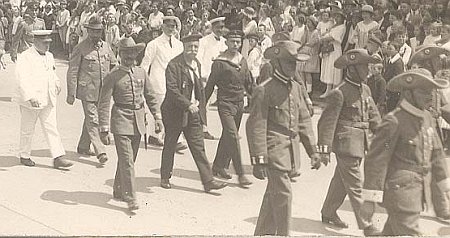
Schutztruppe and Naval Veterans Parade in Munich 1924
Note the 1920s DKKB uniforms with seven buttons down
the front, pleated breast pockets with pointed flaps and Litzen
braid on the colony coloured collar and Swedish style cuffs,
with the foreground figure clearly wearing white for East
Africa, while those behind may have blue for South West Africa
or red for Cameroon.
III. 1930s Uniforms of the Deutsche Kolonial
Kriegerbund
In the early 1930s, the uniforms of the DKKB were standardised. They wore the
Schutztruppe Südwester hat with a German cockade and colony
coloured hatband and edging. The tunic was similar in design to the
Schutztruppe 1896 Tropical Khaki Uniforms, with the same pocket and button arrangements, hussar style
shoulder straps in the German colours but with three notable differences.
Firstly that the tunic itself was now made from khaki corduroy rather than khaki cloth.
Secondly that the tunic itself was now piped in colony colours, whereas as
pre-war Schutztruppe khaki tunics had all been piped in blue. And thirdly that the breast pockets
now had three pointed scalloped pocket flaps rather than the previous straight
ones.

DKKB Tunic
Photo ©
German Militaria
IV. Insignia of the
Deutsche Kolonial
Kriegerbund
Due to their various allegiances within the
political structure over the years the veterans of the
Deutsche Kolonial
Kriegerbund developed several forms of insignia
over the years.
Original Schutztruppe Insignia
The DKKB retained many details of the former Schutztruppe uniform most notably
the same hussar style twisted cord shoulder straps woven in Imperial colours;
bearing the imperial crown on their tunic buttons; wearing the
same red, white and black aiguillette cords from the shoulder
across their left breast as had been worn by officers of the
Schutztruppe of their 1897 home uniforms.
Musicians of the DKKB band
still wore swallows nest insignia on their shoulders as they had done in
colonial times.
Rank Insignia
Deutsche Kolonial
Kriegerbund rank was shown in
the form of bands of white metallic lace on both cuffs with the
upper band having a naval style loop. Note that the DKKB rank did
not correspond directly to the previous rank held by the veteran
in wartime.
Medals
Veterans proudly
wore previous awards for colonial and First World War
service on all uniforms. From 1935 changes were made to the
order in which medals were worn on a bar. These changes included
putting medals awarded for the First World War ahead of any
awarded prior to the war, putting pre-1914 campaign medals ahead
of long service awards and putting awards from other German
states (including Austria after 1938) on a level with Prussian
awards. The Prussian Iron Cross Second class remained superior
to all other medals on a bar.
Peter's Flag Arm Shield
On the left forearm of the tunic was the Peter's Flag
('Petersflagge')
shield badge of the DKKB and RKB based on the flag of the old German East Africa Company
and named after the explorer and ruthless early colonial governor of East Africa, Dr. Carl Peters. It consisted of a white shield
with a black cross. The upper left quadrant was in red with the five stars
of the Southern Cross in white.

Peter's Flag Arm Shield of the RKKB
Note the corduroy weave of the RKKB tunic
Photo ©
German Militaria
V. Colony Colours
Whereas previous Schutztruppe khaki tunics were
piped in blue for all colonies, the DKKB tunics were piped in colony colour. The Südwester
also had its hatband and edging in the colony colour. Colony colours for the
three larger African colonies were the same as before the war, the smaller
colonies now all wore green, while veterans of campaign in China wore yellow.
Blue for service in
South West Africa
White for service in
East Africa
Red for service in
Cameroon
Green for
service in
Togo, New Guinea or
Samoa
Yellow for service in
China
This is where confusion begins among modern
collectors. In the 1912 Schutztruppe uniform regulations, yellow was for Togo,
green was for New Guinea and salmon pink for Samoa. Soldiers serving in China
were either under direct naval or army command, rather than Schutztruppe and so did not
have a colony colour under the Imperial system.
In the 1920s, veterans of
service in China were
incorporated into the DKKB
and so took yellow as a colour colour while the relatively small numbers of
German veterans who had served in Togo and the Pacific were lumped together with green.
This would explain why relatively so many items of Schutztruppe
uniform appear in modern collections and on sales websites have yellow piping.
When we know that only a small handful of German officers served in Togo between the
regulations of 1912 and the outbreak of war two years later, it seems more
likely that some of these items were made in the 1920s/30s for the many veterans of the III.
Seebataillon or East Asian Expeditionary Corps.
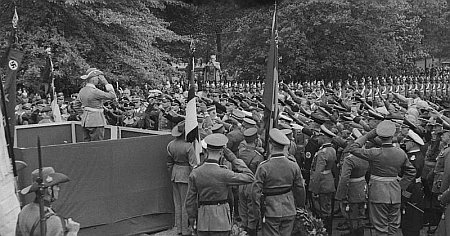
Von Lettow-Vorbeck takes the Salute at Colonial
Day Bremen 1938
Note that while most of those present give the Nazi straight arm salute,
von Lettow-Vorbeck and a few others give the old military salute. Note also the
police guard in the left foreground wearing the Landespolizei Südwester with
large imperial crown on the side.
VI.
Nazi Insignia from 1938
In 1938 the DKKB were incorporated
into the Nazi Reichskriegerbund organisation and wore Nazi insignia added to
their uniforms.
The red swastika armband was worn on the left sleeve and
below it the Peter's Flag badge often had a swastika in the centre of the cross.
The Reichskriegerbund shield was worn on the lower right sleeve. This consisted of a
red shield, bearing a black Iron Cross with a swastika in the centre. The
Reichskriegerbund also wore a white metal badge bearing a Nazi eagle clutching a swastika with a black Iron Cross on
crossed swords above the right breast pocket.
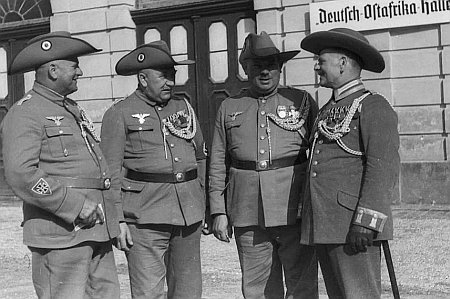
DKKB Veterans
at
Colonial Day Vienna 1939
The NCO on the right wears the old Schutztruppe Home Uniform while the
other
three wear DKKB uniforms with
the Reichskriegerbund shield on the lower right
sleeve and white metal eagle above the right breast pocket. On the right
arm of the centre figure is the swastika armband.
Photo © Frankfurt University Koloniales
Bildarchiv
|
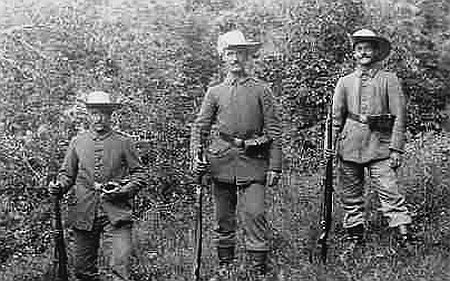
Schutztruppe Veterans in the Landsturm, 1914
Württembergischen Landsturm-Infanterie-Bataillon Gmünd (XIII.19). Note they
still retain the Südwester hat.
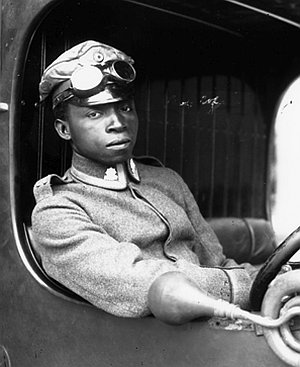
East African Askari Veteran,
Freikorps Lettow-Vorbeck, 1919
He wears field grey modified M1915 uniform with the
collar badge of the Garde-Kavallerie-Schützen-Division.
Photo © Bildarchiv Preußischer Kulturbesitz/ Heinrich Hoffmann
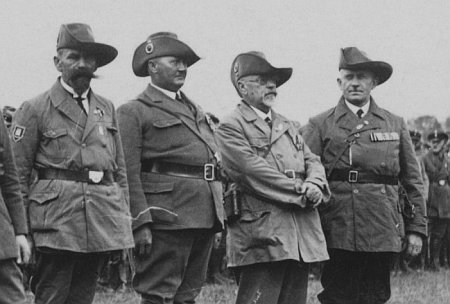
Schutztruppe Veterans in the Stahlhelm, c1920
Note they still retain the Südwester hat
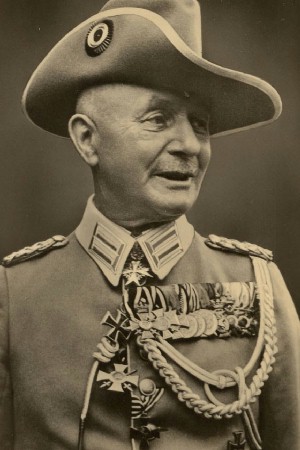
General von Lettow-Vorbeck
Colonial Day Bremen 1938
Like many veterans, the former commander of the East
African Schutztruppe retained his old imperial 1897 Schutztruppe
Home Uniform with matching Südwester hat for
special occasions long after the war. Note the white collar,
cuffs and hat trimming for East Africa.
Photo © Frankfurt University Koloniales
Bildarchiv

East African First World War Veteran
Colonial Day Vienna 1939
He wears the DKKB khaki corduroy uniform with aiguillette cords and a swastika armband.
On the lower left sleeve he has the Petersflagge shield and below that two rank bars
with the naval style loop. His Südwester hat has white edging for
service in German East Africa. He has an impressive display of medals
earned during the First World War including the Prussian Iron Cross, first and second class,
the Bavarian Military Merit Cross and
the 1914-18 Wound Badge.
Photo ©
Frankfurt University Koloniales Bildarchiv

South West African Herero War Veteran
Colonial Day Vienna 1939
He wears the DKKB khaki corduroy uniform with blue edging on his Südwester hat for service in German South West Africa.
Note the Reichskriegerbund shield on the lower sleeve and the white metal
eagle above the breast.
His medal bar shows
the South West Africa 1904-08 Medal with three campaign clasps, the
semi-official
Kreuz Treue dem Regiment and the
Prussian 1897 Wilhelm I Centenary
Medal, showing that at the time of this phtograph, it is at least
forty-two years since this grey bearded veteran first enlisted.
Photo ©
Frankfurt University Koloniales Bildarchiv
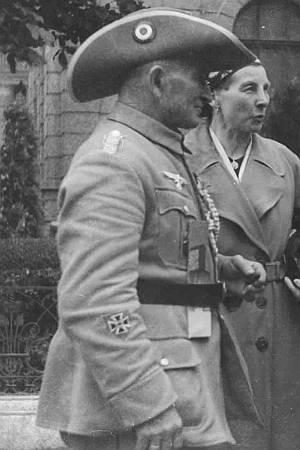
East African Schutztruppe Veteran
Colonial Day Vienna 1939
He wears the DKKB khaki corduroy uniform with
white edging on his Südwester hat for service in German East Africa.
Note the Reichskriegerbund shield on the lower sleeve and the white metal
eagle above the breast.
Photo ©
Frankfurt University Koloniales Bildarchiv
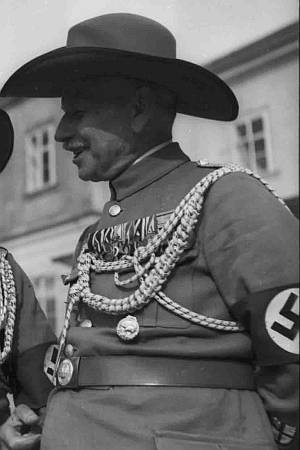
South West African Schutztruppe
Veteran
Colonial Day Vienna 1939
He wears the DKKB khaki corduroy uniform parade aiguillette cords blue
piping and edging on his Südwester hat for service in German South West
Africa.
The Petersflagge badge and swastika armband are just visible on his left
sleeve. He has an impressive display of Prussian and Bavarian medals
including several campaign clasps on the South West African Campaign
medal as well as the Elephant Order for First World War service worn on
the breast.
Photo © Frankfurt University Koloniales
Bildarchiv
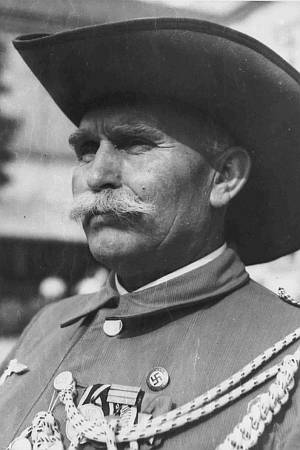
South West African Schutztruppe
Veteran
Colonial Day Vienna 1939
He wears the DKKB khaki corduroy uniform parade aiguillette cords blue
piping and edging on his Südwester hat for service in German South West
Africa. His medal bar shows the South West African Campaign
medal with several campaign clasps, above his medal bar he wears the NSDAP party membership badge.
Photo © Frankfurt University Koloniales
Bildarchiv
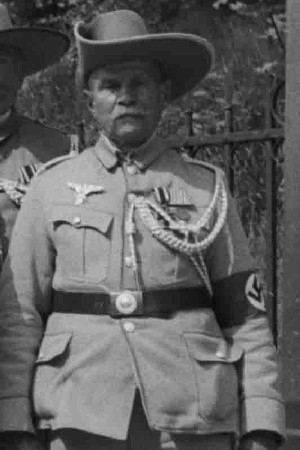
Boxer Rebellion Veteran
Colonial Day
Bremen 1938
He wears the DKKB khaki corduroy uniform
with aiguillette cords, swastika armband and Reichskriegerbund eagle
on the right breast. His Südwester hat has yellow edging for service in China
and his medal
bar shows the Prussian Iron Cross second class for service in
the First World War and the Combatants China Medal for service in the
Boxer Rebellion of 1900-01.
Photo © Frankfurt University Koloniales
Bildarchiv
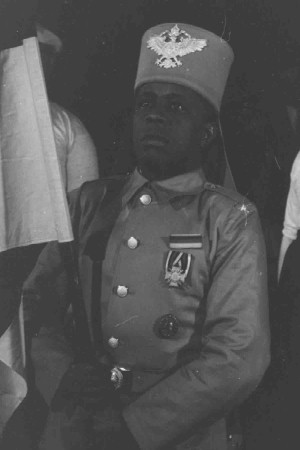
East African Askari Veteran
Colonial Day,
Bremen 1938
Mohamed Husen wears a newly made uniform in the style of the
Schutztruppe askari uniform. It varies only in small details such as the size of the Tarbusch eagle from the original. He wears the
1914-18 Honour Cross for
combatants (although the German authorities had actually refused
to award him the honour as it was only available for white soldiers),
the Prussian wound badge in black for
1914-18 and an unidentified strip of ribbon above them both. Mohamed was
the only former askari to campaign alongside the DKKB, having briefly
served as a signals boy in the Schutztruppe in the First World War. He
relocated to Berlin after the war working as a waiter, musician and
actor (playing roles in several neo-colonial films such as 'Die
Reiter von Deutsch-Ostafrika'
and 'Carl Peters') until Nazi prejudice turned against him. He died in Sachsenhausen concentration camp in 1944.
Photo © Frankfurt University Koloniales
Bildarchiv
|